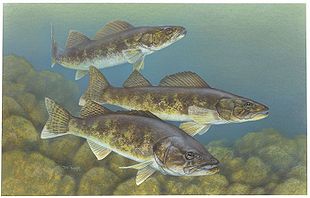
Indian Lake, Minnesota
Encyclopedia
Indian Lake
Indian Lake is a small lake located in Indian Lake Township, Nobles CountyNobles County, Minnesota
Nobles County is a county located in the U.S. state of Minnesota. As of 2010, the population was 21,378. Its county seat is Worthington.-Geography:...
. The lake is an oblong body of water that extends north-to-south for approximately 3/4 mile. The width is approximately 1/2 mile. The lake area is 204 acre (0.82555944 km²). The average depth is 4.48 feet (1.4 m), and the maximum depth is 6 feet (1.8 m). The elevation of the lake is 1536 feet (468.2 m), or 468.17 meters.
History
The lake was named Indian Lake due to the fact that settlers found Native Americans encamped along the lake's shores when they first arrived in 1869. A dozen years earlier, a band of Indians led by InkpadutaInkpaduta
Inkpaduta was a war chief of the Santee Sioux during the 1857 Spirit Lake Massacre and the 1862 Dakota War against the United States Army in Minnesota and the Dakota Territory.-Early life:Inkpaduta was born in what later became the Dakota...
, the group responsible for the 1857 Spirit Lake Massacre
Spirit Lake Massacre
The Spirit Lake Massacre was an attack by a Wahpetuke band of Santee Sioux on scattered Iowa frontier settlements during a severe winter. Suffering a shortage of food, the renegade chief Inkpaduta led 14 Sioux against the settlements near Okoboji and Spirit lakes in the northwestern territory of...
, lived along the shores of the lake. Indeed, the women and children of Inkpaduta's band were camped at Indian Lake when the massacre was taking place. Inkpaduta
Inkpaduta
Inkpaduta was a war chief of the Santee Sioux during the 1857 Spirit Lake Massacre and the 1862 Dakota War against the United States Army in Minnesota and the Dakota Territory.-Early life:Inkpaduta was born in what later became the Dakota...
later fled westward, joining up with the Lakotas. He became a close friend of Sitting Bull
Sitting Bull
Sitting Bull Sitting Bull Sitting Bull (Lakota: Tȟatȟáŋka Íyotake (in Standard Lakota Orthography), also nicknamed Slon-he or "Slow"; (c. 1831 – December 15, 1890) was a Hunkpapa Lakota Sioux holy man who led his people as a tribal chief during years of resistance to United States government policies...
, and participated in the Battle of the Little Bighorn
Battle of the Little Bighorn
The Battle of the Little Bighorn, also known as Custer's Last Stand and, by the Indians involved, as the Battle of the Greasy Grass, was an armed engagement between combined forces of Lakota, Northern Cheyenne and Arapaho people against the 7th Cavalry Regiment of the United States Army...
and the defeat of George Armstrong Custer
George Armstrong Custer
George Armstrong Custer was a United States Army officer and cavalry commander in the American Civil War and the Indian Wars. Raised in Michigan and Ohio, Custer was admitted to West Point in 1858, where he graduated last in his class...
. It is believed that Inkpaduta died in Canada in 1881 or 1882.
Issac Horton, a pioneer settler, was the first to take up permanent residence along the shores of Indian Lake. He had been renting a farm near Spirit Lake, Iowa
Spirit Lake, Iowa
Spirit Lake is a city in Dickinson County, Iowa, United States. The population was 4,261 at the 2000 census. It is the county seat of Dickinson County.The town is located along the western shore of East Okoboji Lake, in the Iowa Great Lakes region....
and frequently came to the Indian Lake region to hunt elk. On May 6, 1869, he filed a preemption claim to the eastern half of section 34 of Indian Lake Township. His claim included the eastern shore of Indian Lake. He erected a cabin of logs cut from his claim, and resided there for 17 years. Horton eventually sold his claim and purchased the southwest quarter of Indian Lake Township section 22 where he resided until his death in 1892.
Throughout the years, Indian Lake has remained entirely rural. It is surrounded by farm land, and several farm families have built homes overlooking the lake. Nobles County maintains one park, Hawkeye Park, along the shores of Indian Lake.
Fishing in Indian Lake

Public access
Public access to Indian Lake can be found on the southwestern side of the lake at Hawkeye Park. This park is maintained by Nobles CountyNobles County, Minnesota
Nobles County is a county located in the U.S. state of Minnesota. As of 2010, the population was 21,378. Its county seat is Worthington.-Geography:...
and consists of 5.4 acres (21,853 m²) developed and 35.7 undeveloped acres. The park includes a paved boat ramp.

